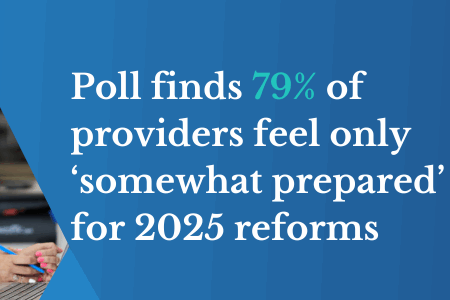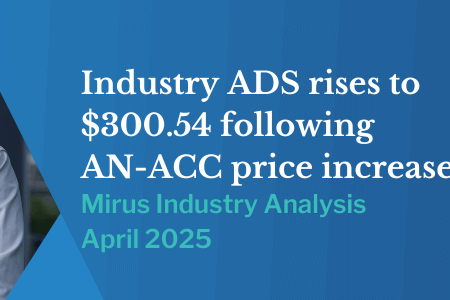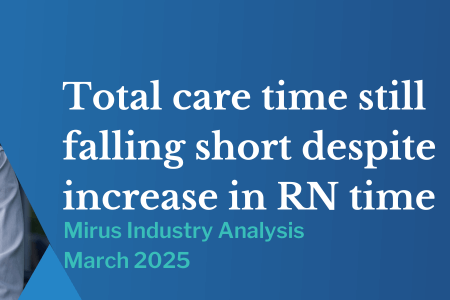Answering your AN-ACC frequently-asked questions
March 4, 2022 | AN-ACC

By Petra Awad, Senior Consultant
On the 24th of February, we launched our survey on what CEOs are thinking about AN-ACC and how they are preparing their organisations. If you missed it, you can find the survey and the webinar recording here.
The webinar chat was alive with questions. We know how many competing pressures the industry is facing and the idea of absorbing a whole new funding system is overwhelming. This blog answers these questions raised and provides some resources to help you continue your AN-ACC learning journey.
Budget planning
“How do we begin to budget for the next Financial Year?”
Now is the time that providers are looking toward the next financial year and planning their budgets. It may be daunting going into this period without a complete picture of what your revenue stream is going to look like.
We believe you can break it down simply by:
- Using our ACFI to AN-ACC resident report in Mirus Metrics (free benchmarking version available) we can help you predict what funding you will have available for Q2-Q4 at the facility level. The full Mirus Metrics version will give you resident level information. Your ACFI team can then refine the data to be as true to your residents’ projected AN-ACC as possible.
- Also consider reconciling your past Medicare statements so you are not missing past revenue owed.
- Finally, stay focused on optimising your ACFI revenue NOW so you can start Q1 off strong (we will still have ACFI July to September in FY23).
Until we see the results of the AN-ACC shadow assessment and receive a decision on the NWAU price, the Mirus reports on your current data provide the best model to inform your decision making. We are available to talk to you about your financial data in more detail and help you understand how AN-ACC will affect different facilities and resident cohorts.
Transition planning
“For a small standalone RACF, what would be the recommendation for change/transition preparedness? Can Mirus support small homes in this process?”
“Given the likely significant cost of the transition (from staffing, training, systems, etc) have Mirus conducted modelling to project a total cost to the industry or a Provider average?”
“For various reasons we moved from a dedicated ACFI Team to embedding ACFI management into each unit, which for us has been a good move. Could this be a deficit in the new world?”
In terms of projecting the cost of your transition or your future operating model, this will inevitably vary case by case. For example, some providers may have rostering and Business Intelligence systems already in place that are prepared for the new complexity of data visibility needed, while others might need to find new vendors. Depending on the number of facilities and availability of skilled staff, you may decide centralising AN-ACC staff makes sense for you. There is no one size fits all, however, you can start breaking down your own preparedness by completing our MAAP diagnostic tool.
Whether a big or small provider (or one site), the Mirus approach stays the same – we work directly with your executive and key stakeholders to map out exactly what is needed to transition your organisation to suit AN-ACC. Several changes will need to be made to your business across Finance, People, Process, Systems and Data in readiness for the cut over to the new funding model. Our AN-ACC PMO service will help you stay on track to meet the deadlines required.
The new AN-ACC model is expected to be implemented as early as October 2022. When both previous funding models (RCS and ACFI) were introduced, industry funding growth was flat for 3 consecutive years due to the industries’ slow adoption of the changes. The purpose of the ANACC PMO is to support your organisation to be ahead of the curve and be prepared for the changes.
This change in the funding model will be significant in several ways:
- The assessments will move from internally produced to externally assessed
- The model will move to a case mix model
- The diagnostics will change and staff will need to be retrained
- ACFI resources will need to move into changed roles
- Data and systems will need to change to accommodate new information
- Finance functions will need to be prepared for new reconciliation processes
Mirus will work with you across the following activities:
- Set up a Program Management Office (PMO) with you to manage the program and set up initial governance
- Build a high-level implementation plan to determine the timing, investment and order of implementation
- Create working groups inside your organisation and tasks to be completed
- Support the project management of the program by managing the steering committee for the program
- Providing industry insight and updates on AN-ACC for your organisation
- Providing access to additional services including AN-ACC training
In our approach we leverage our knowledge of AN-ACC, experience in transformation/program management and your knowledge of your business.
Government funding
“Is the funding just a reallocation of the existing bucket of funding…as there has been no visibility of the shadow assessments and how they compare to current ACFI levels.”
“Has there been any discussion about grandparenting and a guarantee about not getting less money for any resident?”
“If there is a change in Federal Government at the May election will this potentially impact the AN-ACC reforms?”
“We need Aged Care Pricing authority to set up first. Will the government do it that way?”
Along with the current pool of aged care funding, the Government has committed $17.7 billion over five years in additional aged care funding. These funds are made up of $3.9 billion to increase the amount of front-line care minutes and $3.2 billion to fund a Basic Daily Fee Supplement of $10 per resident per day. These will all be wrapped up in the AN-ACC subsidy along with the Viability and Homeless supplements. Therefore, the Average Daily Subsidy will be higher with AN-ACC than what it is today with ACFI.
It is important to note that the Basic Daily Fee Supplement, the Viability supplement, and the Homeless supplement are paid today and will simply transition from a dedicated supplement to part of the AN-ACC subsidy, so this is not new revenue. Using this available knowledge, we have been able to formulate an NWAU projection of approximately $198. The Government has also said they will consider the industry ADS at the time of the announcement and it will be indexed for the next financial year.
According to all official published sources, there will be no grandfathering of ACFI and no stop-loss mechanism. On 1 October 2022, all residents will switch to the AN-ACC class assessed during the shadow assessments process.
The timeframe for implementation of AN-ACC may change as the enabling legislation has not been passed by the parliament, however, as we are at the third reading and there are multiple parliament sitting days between now and May we anticipate it will pass before an election. Of course there is always the opportunity for new governments to change legislation but it appears this bill has bi-partisan support.
The existing Independent Hospital Pricing Authority, will be renamed the Independent Hospital and Aged Care Pricing Authority (IHACPA). IHACPA will inform decisions on annual funding increases in residential aged care from 1 July 2023. For more information on reforms related to AN-ACC visit this link.
Allied health
“How much time (if any) are you spending considering the role of allied health in AN-ACC?”
“Doesn’t the financial reward come if someone enters the facility at a high level of care and is able to improve with allied health input – then the provider receives a higher level of funding at a reduced burden of care?”
Your Allied Health teams will be just as important in the AN-ACC world for a few reasons:
- They will be needed to assess mobility and other functional needs prior to an AN-ACC assessment.
- They will still need to help determine the best intervention for residents dealing with, for example, chronic pain, dysphagia, equipment needs, preventing falls, and Reablement after an incident.
- Access to their services is an attractive value proposition when speaking with prospective consumers.
- Under the Aged Care Quality Standards their services relate to several principles.
While AN-ACC does not prescribe specific interventions as ACFI did, it does factor in the cost of these services as part of both the fixed and variable costs. You will now have much more flexibility in terms of what your allied health program will look like in future – whether it is more wellness activities vs massage, group vs individual sessions, or self-funded physio programs, it is an opportunity to shape programs that are more evidence based and person centred. Now is the time to review and transition your 12.4a and 12.4b programs over the next 6 months.
The underpinning principle of AN-ACC is for Reablement, as we will see below there is less incentive to drive up the AN-ACC class of residents. However, if a resident enters on a higher AN-ACC and improves over time, while there is no requirement to reassess them, it will also not change the minimum care minute requirement as it is based on current AN-ACC scores.
Mandatory Care Minutes
“My understanding is the 200 minutes is an average over the week/fortnight, but it is the minimum, am I mistaken?”
“Will the care minutes flex much in line with AN-ACC or is this this still an unknown?”
“Will the care minutes be validated to ensure minutes per site based on AN-ACC scores are met?”
“I am interested in how care minutes will be provided to the regulator?”
The 200 minutes of care per day (including 40 minutes of Registered Nurse time) is an average target across the sector, made up of your RN, EN and Personal Care Workers time. Each facility will have a unique care time target (higher or lower), depending on the AN-ACC case mix classification of their residents, at a point in time. This means that as the AN-ACC case mix classification changes within a site, the subsidy paid by the minute will also change.
From July 2022, providers will be required to provide monthly care statements to residents (and their families) outlining the care they have received and any significant changes or events during the month. Reporting on care staffing minutes will move to a quarterly basis. From December 2022 – Information collected from staffing minutes will be used as a contributing factor in star ratings. To read more about preparing for the mandatory care time reforms and reporting, read this blog post .
Dynamic Rostering
“Will the implementation of the 200 care minutes per resident per day (October 2023) mean that there won’t be a need for dynamic roster changes as the 200 minutes will be higher than the case management required anyway?”
“Given our current staffing issues, lack of RNs and then take into account managing clinical risk and coverage in buildings, and our current industrial agreements, I am very unclear about dynamic rostering”
With AN-ACC, more revenue may not always be the best outcome for all facilities. This is because it may drive further reliance on heavy rosters, which means providers may have their star ratings significantly impacted if they cannot track their ongoing requirement through daily rostering periods.
In this video Rob Covino, explains more about a predictive roster versus a reactive roster in managing AN-ACC care minutes.
RCS and ACFI operated more independently from the rostering and admissions functions. AN-ACC will directly link the three, with each change in AN-ACC, along with admissions and departures, changing the minimum care minutes a facility will need to deliver.
Every facility will have its own unique balance that will yield the best financial results and allow them to deliver the best care for their residents, although all three functions must work together. This will see a greater reliance on real time data insights to run a sustainable operation. To read more about AN-ACC’s impact on rostering, see this blog post.
Star ratings
“Are the four-star rating categories equally weighted?”
Star ratings will be published on My Aged Care by the end of 2022. Residential aged care services will have an overall star rating, as well as against 4 sub-categories:
- Five quality indicators
- Service compliance ratings
- Consumer experience
- Staff care minutes
Weighting of the categories are not equal, consumer experience reviews and care minutes have the most weighting at this point in time. The research consortium developing this will develop an algorithm underpinning the star rating system based upon the review of evidence and the sector and consumer consultation activities. Once you receive a star rating it will most likely be reviewed quarterly.
Assessor qualifications
“Who is assessing AN-ACC? What is their qualification and aged care administrative experience?”
The Department of Health has contracted several independent Assessment Management Organisations to undertake assessments. According to the information provided on the assessment process, assessors will be registered and trained in the AN-ACC tool, and must have 5 years’ minimum experience as a registered nurse, physiotherapist or occupational therapist delivering clinical services in aged care settings.
Assessment tools & process
“For regional providers, waiting on an assessor may take some time. If the resident dies during the wait, my understanding is the assessment will take place using documentation. So we will essentially have to prepare ACFI/AN-ACC packs as we do now to manage the risk?”
“Will there be a tool developed to determine ‘social interaction, problem solving, memory’ or will we use something that is currently available?”
“Will our assessments and care plans be used to inform the AN-ACC?”
“So, we should be transitioning to using the AN-ACC assessment tools?”
Assuming the current enabling legislations passes, a new classification resulting from a classification request will have effect from the date of the request. So, in the event a resident discharges before an assessor visit, they will use the available information to complete the assessment. Similar to validation or accreditation, to complete the AN-ACC Assessment tool assessors rely on observation and conversation with the resident, interview of key personnel, and all available clinical data sources.
This means that accurate assessment and recording of a resident’s care needs are just as important with AN-ACC as ACFI. The external assessors will rely on clinical assessments in your care management system, as well as progress notes, incident reports, falls history, wound charts and many other data points.
Education and understanding the AN-ACC Assessment tool thoroughly is key to ensuring you are capturing the right information which evidences your desired case mix outcome. It may not be necessary to complete an “AN-ACC pack” but knowing where an assessor might look and reviewing the frequency and accuracy of that information is critical. Now is the time to also start having conversations with your care management system provider to find out how they are preparing for AN-ACC – will the Assessments be available in the CMS? Will AN-ACC specific reporting be available?
Respite
“How will it impact the respite funding and how will they be assessed”
New residential respite funding will also be introduced from 1 October 2022. Respite residents will be assessed with the same AN-ACC Assessment tool and will have three separate classes (low, medium, high care). See this link for more information.
If you would like more information from our Revenue and Data Consultants on any of these themes (or if this blog brought up more questions), feel free to get in touch with us anytime. We’re here to help!
In our next webinar we look at Data-led decisions in an AN-ACC world so make sure you sign up to our alerts.


